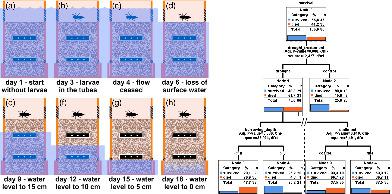当前位置:
X-MOL 学术
›
Ecol. Entomol.
›
论文详情
Our official English website, www.x-mol.net, welcomes your
feedback! (Note: you will need to create a separate account there.)
What to do if streams go dry? Behaviour of Balkan Goldenring ( Cordulegaster heros , Odonata) larvae in a simulated drought experiment in SW Hungary
Ecological Entomology ( IF 2.0 ) Pub Date : 2020-08-25 , DOI: 10.1111/een.12931 Bálint Pernecker 1 , Péter Mauchart 1 , Zoltán Csabai 1, 2
Ecological Entomology ( IF 2.0 ) Pub Date : 2020-08-25 , DOI: 10.1111/een.12931 Bálint Pernecker 1 , Péter Mauchart 1 , Zoltán Csabai 1, 2
Affiliation

|
In case of dryings, the hyporheic zone is one of the most important refugia for stream macroinvertebrate communities, including the few Odonata species living in these habitats, such as Cordulegaster species. There is no information on the desiccation resistance strategies and methods of any members of the genus, including Cordulegaster heros. We hypothesised that the larvae use burrowing behaviour to survive droughts. In this study, beyond recording the survival rates of the larvae, we tested the effects of the sediment particle size and the body size of the larvae on burrowing behaviour in a 3‐week‐long simulated drought experiment in an indoor artificial stream system. Eighty larvae were involved in the experiment, from which 60 were treated with drought, and 20 served as controls. Larvae were put into flowing water, into separate special compartments; 1 day later, the flow was ceased, and then, the water level was gradually decreased for 3 weeks. Approximately 15% of larvae could survive the 3 weeks of drying. The survival probability of drought‐treated larvae was significantly increased if animals burrowed into the sediment. In addition, the survival probability was higher in case of fine substrate material. Size of the larvae only affected the depth of the burrowing, not the survival rate. However, two‐thirds of the larvae did not dig into the sediment, which implies that surviving via burrowing is not the only mechanism of the species to withstand dry periods.
中文翻译:

如果溪流干涸怎么办?巴尔干金环(Cordulegaster heros,Odonata)幼虫在匈牙利西南部模拟干旱试验中的行为
在干旱的情况下,潜流带是大型无脊椎动物群落最重要的避难所之一,包括生活在这些栖息地的少数 Odonata 物种,例如 Cordulegaster 物种。没有关于该属任何成员(包括 Cordulegaster 英雄)的抗干燥策略和方法的信息。我们假设幼虫使用穴居行为来度过干旱。在这项研究中,除了记录幼虫的存活率之外,我们还在室内人工河流系统中进行了为期 3 周的模拟干旱实验,测试了沉积物粒径和幼虫体型对穴居行为的影响。80只幼虫参与实验,其中60只进行干旱处理,20只作为对照。幼虫被放入流水中,进入单独的特殊隔间;1天后停水,水位逐渐下降3周。大约 15% 的幼虫可以在 3 周的干燥后存活。如果动物钻入沉积物中,经过干旱处理的幼虫的存活概率会显着增加。此外,在精细基板材料的情况下,存活概率更高。幼虫的大小只影响挖洞的深度,而不影响成活率。然而,三分之二的幼虫没有钻入沉积物中,这意味着通过穴居生存并不是该物种抵御干旱期的唯一机制。如果动物钻入沉积物中,经过干旱处理的幼虫的存活概率会显着增加。此外,在精细基板材料的情况下,存活概率更高。幼虫的大小只影响挖洞的深度,而不影响成活率。然而,三分之二的幼虫没有钻入沉积物中,这意味着通过穴居生存并不是该物种抵御干旱期的唯一机制。如果动物钻入沉积物中,经过干旱处理的幼虫的存活概率会显着增加。此外,在精细基板材料的情况下,存活概率更高。幼虫的大小只影响挖洞的深度,而不影响成活率。然而,三分之二的幼虫没有钻入沉积物中,这意味着通过穴居生存并不是该物种抵御干旱期的唯一机制。
更新日期:2020-08-25
中文翻译:

如果溪流干涸怎么办?巴尔干金环(Cordulegaster heros,Odonata)幼虫在匈牙利西南部模拟干旱试验中的行为
在干旱的情况下,潜流带是大型无脊椎动物群落最重要的避难所之一,包括生活在这些栖息地的少数 Odonata 物种,例如 Cordulegaster 物种。没有关于该属任何成员(包括 Cordulegaster 英雄)的抗干燥策略和方法的信息。我们假设幼虫使用穴居行为来度过干旱。在这项研究中,除了记录幼虫的存活率之外,我们还在室内人工河流系统中进行了为期 3 周的模拟干旱实验,测试了沉积物粒径和幼虫体型对穴居行为的影响。80只幼虫参与实验,其中60只进行干旱处理,20只作为对照。幼虫被放入流水中,进入单独的特殊隔间;1天后停水,水位逐渐下降3周。大约 15% 的幼虫可以在 3 周的干燥后存活。如果动物钻入沉积物中,经过干旱处理的幼虫的存活概率会显着增加。此外,在精细基板材料的情况下,存活概率更高。幼虫的大小只影响挖洞的深度,而不影响成活率。然而,三分之二的幼虫没有钻入沉积物中,这意味着通过穴居生存并不是该物种抵御干旱期的唯一机制。如果动物钻入沉积物中,经过干旱处理的幼虫的存活概率会显着增加。此外,在精细基板材料的情况下,存活概率更高。幼虫的大小只影响挖洞的深度,而不影响成活率。然而,三分之二的幼虫没有钻入沉积物中,这意味着通过穴居生存并不是该物种抵御干旱期的唯一机制。如果动物钻入沉积物中,经过干旱处理的幼虫的存活概率会显着增加。此外,在精细基板材料的情况下,存活概率更高。幼虫的大小只影响挖洞的深度,而不影响成活率。然而,三分之二的幼虫没有钻入沉积物中,这意味着通过穴居生存并不是该物种抵御干旱期的唯一机制。











































 京公网安备 11010802027423号
京公网安备 11010802027423号